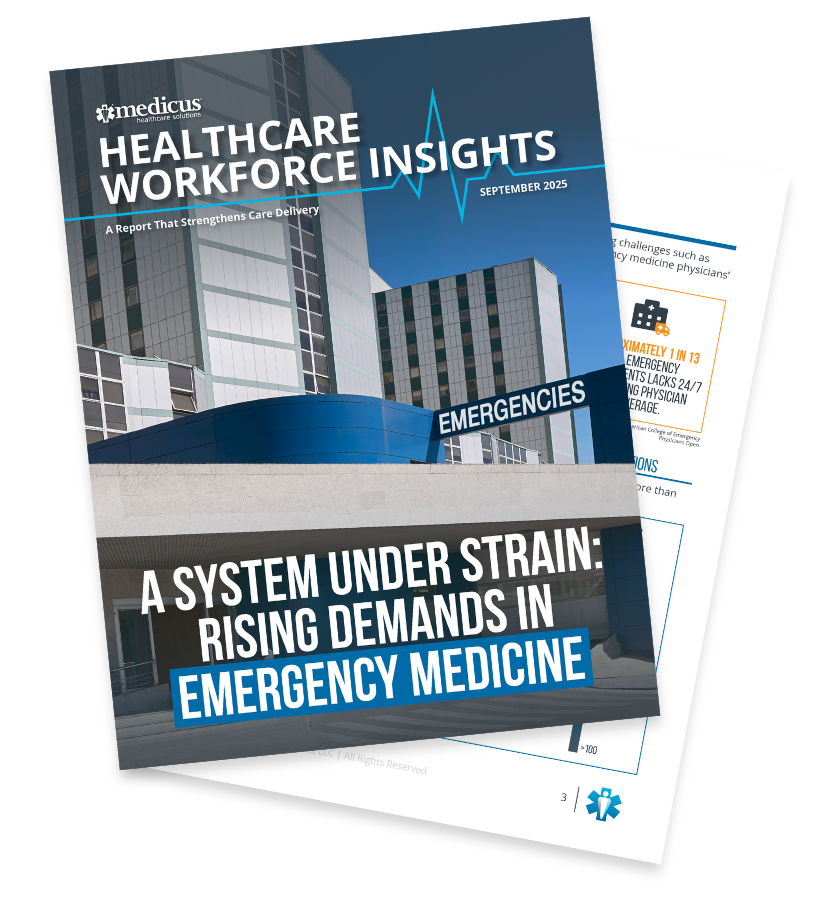Exploring the Rising Demands in Emergency Medicine

Emergency departments (EDs) have long been built to manage the unpredictable. Yet in many hospitals today, what were once intermittent surges in patient volume and acuity have become everyday conditions. Stretchers line hallways, clinicians juggle complex cases, and throughput slows as teams work to keep up.
While the intensity varies across regions, the underlying challenge is shared: demand for emergency care is outpacing the system’s capacity to respond. In this environment, understanding how these pressures lead to boarding, overcrowding, and longer visits is key to developing sustainable solutions.
The Current ED Landscape
Emergency departments have become a central access point for hospital care in the United States. The Centers for Disease Control and Prevention reports that more than 155 million patients visit emergency departments annually, and 17.8 million of those encounters lead to hospital admission. These volumes reflect how EDs serve as both an entryway to inpatient services and a safety net for patients who cannot obtain care elsewhere.
ED Boarding & Throughput Trends
As patient volumes grow, moving admitted patients from the ED to inpatient units has become increasingly difficult. Boarding delays, which were once mainly a seasonal issue, now occur throughout the year.
A study published in Health Affairs found that over the past three years, more than one-quarter of patients admitted through the emergency department waited at least four hours for a hospital bed during non-peak months. That number rose to 35% during the winter months. In 2024, almost 5% of admitted patients, about 2.3 million individuals, remained in the emergency department for 24 hours or longer during peak periods. Even in the lowest-boarding months of that year, the share of patients waiting four or more hours surpassed the highest levels recorded between 2017 and 2019. Before the COVID-19 pandemic, fewer than 5% of patients waited longer than 12 hours for a bed, even during peak demand. Today, that figure rarely falls below 5%, illustrating how ED boarding has shifted from a seasonal problem to a persistent operational concern.
 Physician Shortages & Their Effects on ED Demand
Physician Shortages & Their Effects on ED Demand
Beyond rising patient volumes and increasing case complexity, physician shortages are adding additional pressure to EDs. Limited access to primary care and behavioral health services leaves many patients without timely options for routine or urgent needs, prompting a turn to EDs for conditions that could often be addressed earlier in other clinical settings.
The Health Resources & Services Administration (HRSA) defines Health Professional Shortage Areas (HPSAs) as geographic areas, populations, or facilities where the supply of clinicians is insufficient to meet the population’s healthcare needs. In the U.S., more than 76 million Americans live in designated primary care HPSAs, with those numbers equating to less than 50% of the U.S. population's primary care needs being met. Residents of primary care HPSAs often face limited access to routine and preventative care, leading to delayed treatment and increased reliance on emergency departments.
In psychiatry, over 120 million Americans live in designated mental health HPSAs, with these numbers equating to less than 25% of the U.S. population's mental healthcare needs being met. As of June 2025, nearly 1 in 20 ED visits (roughly 7.7 million) each year were mental health-related. With the U.S. only having 28.4 inpatient psychiatric beds per 100,000 people, well below the optimal level of 60 beds, this places further strain on emergency departments as patients wait for appropriate placement or care.
Projecting Demand and Capacity Pressures Over the Next Decade
Despite ongoing efforts to mitigate operational strain within the ED, pressures are projected to intensify over the next decade. Forecasts indicate that ED volumes are projected to rise by 5% due to access barriers and higher clinical acuity.

Research published in JAMA Network Open, titled Healthcare Staffing Shortages and Potential National Hospital Bed Shortage, estimates that national hospital occupancy could reach 85% for adult beds by 2032, citing three main drivers, including an aging population and rising hospitalizations, a reduction in staffed hospital beds, and state-level variability and system strain. These trends suggest that without targeted interventions in workforce and capacity planning, EDs may face continued challenges in sustaining access to timely care.
Approaches to Supporting Emergency Department Access
Optimizing Clinical Workforce Efficiency & Patient Flow
Targeted staffing strategies, efficient triage processes, and balanced workloads are essential to maintaining both patient care quality and clinician well-being.
Key Strategies for Workforce Optimization Include:
- Adjust Staffing Models: Ensure staffing levels are aligned with peak times to meet patient demand effectively.
- Streamline Triage and Flow: Implement fast-track pathways and advanced triage to expedite care for low-acuity patients, easing ED congestion while preserving timely access for high-acuity cases.
- Manage Physician Workload: Delegate routine tasks, incorporate flexible staffing models, and promote initiatives that reduce staff fatigue and burnout.
A proactive, data-driven workforce strategy not only improves patient flow and operational efficiency but also reinforces team resilience, positioning emergency departments to deliver consistent, high-quality care in the face of rising ED demand.
Integrating Interim Healthcare Staffing in Long-Term Workforce Planning
Emergency medicine locum tenens physicians and advanced practice providers can offer an additional layer of support for emergency departments experiencing clinical staffing shortages. While previously viewed as a temporary solution, interim healthcare staffing is increasingly being integrated into long-term workforce strategies.
Benefits of Emergency Medicine Locum Tenens:
- Ensures continuous coverage.
- Enhances operational stability.
- Reduces provider burnout.
- Expands access to care, particularly in rural or underserved areas.
By incorporating locum tenens coverage into broader workforce planning, health systems can strengthen their ability to maintain consistent emergency care access.
For a deeper look at these insights and more, download the complete white paper, A System Under Strain: Rising Demands in Emergency Medicine, below.


.png)
